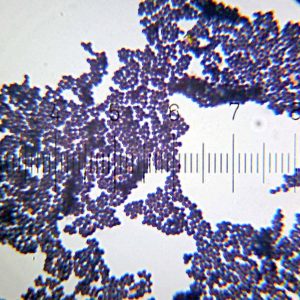Titanium is commonly used to make implants (3). However, the implant’s surface poses as a health issue when bacteria can adhere and prevent the skin tissues from healing properly with the implant following surgery (3).
A recent publication in Nature’s Scientific Reports by Wang and colleagues showed supportive evidence that titanium surface combined with silver (Ag) nanoparticles and silver ions (Ag+) release are able to inhibit the growth of Staphylococcus aureus, which is a spherical non-motile type of bacteria that is commonly found in skin and mucous membranes (2), and other strains of Staphylococcus, such as S. epidermis, that are motile (3).

Figure 1. Staphylococcus Under Magnification (Image Courtesy of Wikimedia Common; Author: Bob Blaylock; Source: Picture Uploaded by Original Photographer)
Wang and colleagues varied the amount of Ag nanoparticles (Ag-0, Ag-0.01, Ag-0.1) on titanium plates and exposed bacteria to the surfaces (3). In doing so, they found that higher amounts of Ag nanoparticles had higher antimicrobial properties for motile and non-motile bacteria compared to lower amounts of Ag nanoparticles or titanium plates alone (3). Moreover, Wang and researchers analyzed how Ag nanoparticles affected the biofilms of non-motile bacteria. By definition, biofilms are a bacterial population that is held together by extracellular matrix, which are molecules secreted by individual bacteria cells (1).

Figure 2. Scanning electromicrograph of Staphylococcus aureus. (Image Courtesy of Wikimedia Common; Author: National Institute of Allergy and Infectious Diseases (NIAID); Source: Picture Uploaded on Flickr)
Wang and colleagues observed that bacterial populations grew under Ag-0 and titanium plate alone. While, there was a significantly smaller bacterial population under Ag-0.01 and no biofilm was formed under Ag-0.1. Wang and colleagues also applied both bacterial and mammalian cells to a titanium plate with varying concentrations of Ag nanoparticles (3). They observed that over time, Ag-0.01 had developed a comparatively large population of mammalian cells attached to the plate. While Ag-0.1 had little growth of mammalian cell population, and both Ag-0 and titanium plate alone showed no living mammalian cells (3).
Biofilms of bacteria, such as Staphylococcus, are one of the main reasons why people have infections following an implant. Due to supportive evidence of antimicrobial properties and mammalian cell growth in Ag nanoparticles, further studies should be conducted on the appropriate concentrations of Ag nanoparticles to be integrated into the surface of titanium implants in hopes that future patients will have successful implants.
–Gloria Kwong
References:
- López, D.; Vlamakis, H.; Kolter, R. Biofilms. Cold Spring Perspectives in Biology 2010, 2 (7). http://doi.org/10.1101/cshperspect.a000398 (Accessed October 17th, 2016).
- Martin, E. Staphylococcus; 2015. http://www.oxfordreference.com.ezproxy.library.ubc.ca/view/10.1093/acref/9780199687817.001.0001/acref-9780199687817-e-9542 (Accessed October 17th, 2016).
- Wang, J.; Li, J.; Guo, G.; Wang, Q.; Tang, J.; Zhao, Y.; Qin, H.; Wahafu, T.; Shen, H.; Liu, X.; Zhang, X. Silver-nanoparticles-modified biomaterial surface resistant to staphylococcus: new insight into the antimicrobial action of silver. 2016, 6, 32699.
